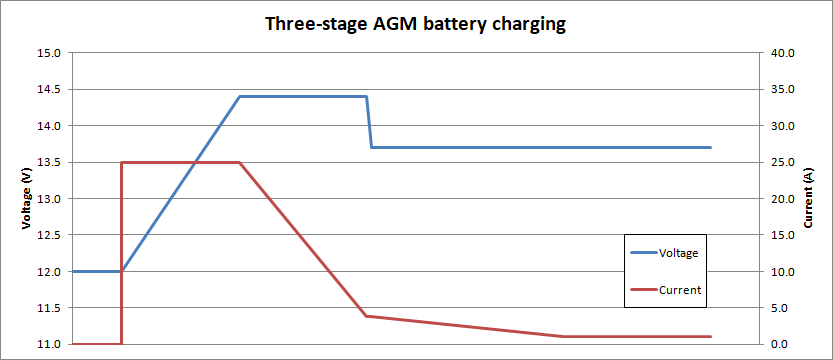Lead-acid batteries must be charged carefully.
The chemical reaction involving the transfer of sulphate ions from the lead plates to the electrolyte can only go so fast. If too much current is supplied toward the end of the charging process, or if the battery is allowed to overcharge, gas can accumulate, leading to the loss of electrolyte. Sealed lead-acid batteries, such as gel and AGM types, include a valve which allows excess gas to be released, but the electrolyte in those batteries cannot be topped up, meaning that they lose capacity if not charged correctly.
Lead-acid batteries can be safely charged by supplying a continuous float voltage of typically 13.7 volts, a method often referred to as trickle charging. This is enough to steadily and safely charge the battery, and maintain the charge, keeping the battery topped-up and ready for use.
Trickle charging is however a slow process, and if you’re charging a battery while driving or from solar panels, you’ll usually want to charge it as quickly as possible to take best advantage of whatever power you have available.
Initially, a discharged lead-acid battery can accept a high charging current, often 30 amps or more. The challenge is to know when to ease back on the current, to allow the battery to safely absorb the charge toward the end of the charging process. That’s what a smart charger is for – it monitors the charging current and voltage, adjusting them through a series of stages until the battery is fully charged.
Although some chargers advertise that they have six or seven charging stages, at minimum lead-acid batteries should be charged in three stages: bulk, absorption and float, as illustrated below.

This graph shows a 12-volt AGM battery that has been discharged to 12.0 volts.
Bulk
In the bulk stage, the charger supplies a constant and reasonably high current (say 25 amps). The battery voltage begins to climb as it accepts the incoming charge, and continues to increase up to some set voltage limit.
The bulk charging current should be matched to the battery capacity. Higher-capacity batteries can generally accept a higher charging current. Of course it’s safe to use a lower charging current than the battery is rated for, it will just take longer to charge. But if the current is too high for the battery, you risk damaging the battery. Many smart chargers allow the bulk charging current to be set – you should always ensure that it’s set correctly for your batteries.
The voltage limit depends on the battery chemistry. For gel batteries the limit is typically 14.1 V, while for AGM it is usually set to 14.4 V and for wet (flooded) batteries it is usually 14.7 V.
If your charger allows you to specify the battery type (gel, AGM or wet), it is important to match this to your batteries to ensure that the correct maximum charging voltage is applied.
Absorption
When the battery has been charged up to the set voltage limit (e.g. 14.4 V for AGM batteries), the battery will have been approximately 80% charged and the charger will switch to absorption mode.
The voltage is held steady while the charge continues to be absorbed, at a lower and lower rate, until the charging current falls to some lower limit (say 3.8 amps).
At this point the point the battery will be almost fully charged.
Float
The final float stage maintains the battery at a lower voltage (typically 13.7 or 13.8 V), which allows it to gradually top up to a full 100% charge and stay there.
If left to itself, a lead-acid battery will slowly self-discharge, losing perhaps 2 or 3% charge per day, even when it’s not used. If an unused battery self discharges and then you charge it again, that still counts as a discharge/charge cycle and reduces the battery’s life, in the same way as if you’d been using it.
Therefore to maximise a lead-acid battery’s life, it should be maintained at the float voltage, whether by a smart charger or a trickle charger.
Conclusion
To look after your lead-acid batteries, don’t allow them to discharge too far, charge them using a three-stage charger, and keep them fully charged between uses.
